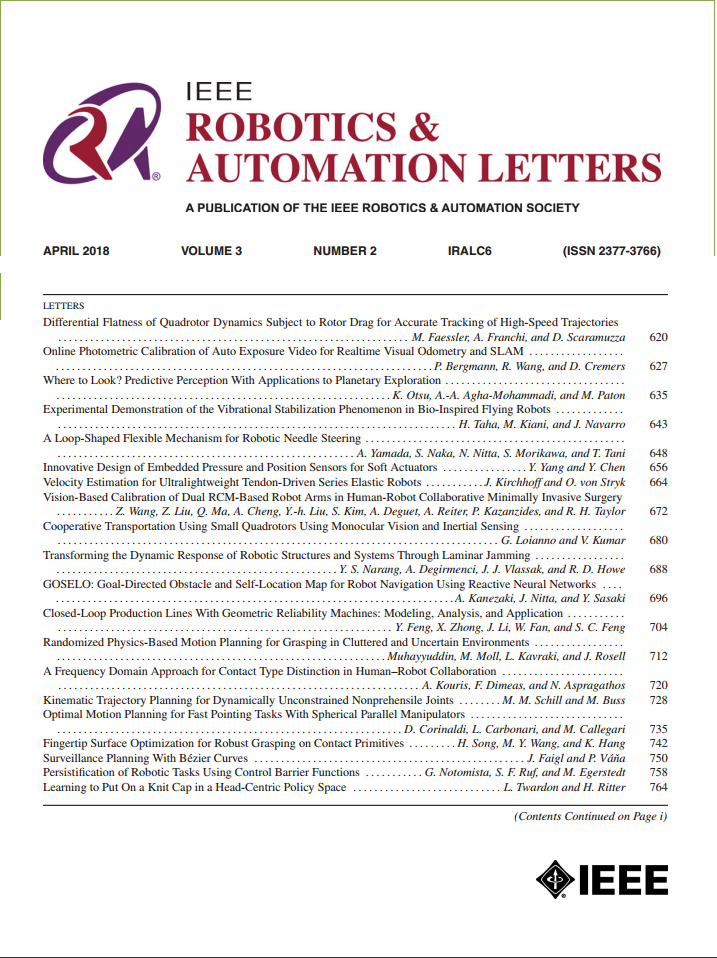SkateDuct:利用矢量推力的管道风扇无人机的地面空中运动
IF 4.6
2区 计算机科学
Q2 ROBOTICS
引用次数: 0
摘要
风道风扇无人机(DFUAVs)具有矢量推力、垂直起降(VTOL)能力和高安全性等特点,在军事和民用领域都有广泛的应用。然而,它们有限的耐用性仍然是其广泛应用的一个重大限制。为了应对这一挑战,在这封信中,我们探索了一种新的方法,利用dfuav的矢量推力能力,通过简单的修改,无需额外的执行器,即可实现地面空中运动。提出了一种采用被动轮的地面和空中连续作业无人机的设计方案。这种配置允许在地面运动时保持不变的姿态和静态稳定性,重量仅增加10.3%。通过流体仿真分析了控制叶片在地效作用下气动效率的变化规律,建立了基于实验数据的经地效调整的气动模型。此外,分析了地面运动的动力学特性,开发了相应的控制器,建立了一个完整的陆空模式无缝转换框架。大量的实际飞行实验验证了所提出的结构设计和控制方法。通过利用地面运动,无人机的能耗降低到飞行时的33.9%,有效地将其运行时间延长了十倍以上。本文章由计算机程序翻译,如有差异,请以英文原文为准。
SkateDuct: Utilizing Vector Thrust of Ducted Fan UAVs for Terrestrial-Aerial Locomotion
Ducted fan UAVs (DFUAVs), characterized by vector thrust, vertical takeoff and landing (VTOL) capabilities, and high safety, have found widespread applications in both military and civilian scenarios. However, their limited endurance remains a significant constraint on their broader applications. To address this challenge, in this letter we explore a novel approach that exploits the vector thrust capabilities of DFUAVs to enable terrestrial-aerial locomotion through simple modifications without the need for additional actuators. The design of a DFUAV employing passive wheels for continuous ground and aerial operation is presented. This configuration allows for unchanged attitude and static stability during ground movement, with only a 10.3% increase in weight. Fluid simulations were conducted to analyze the variation in control vane aerodynamic efficiency under ground effect, leading to the development of a ground-effect-adjusted aerodynamic model based on experimental data. Furthermore, the dynamics of ground movement are analyzed, and a corresponding controller is developed, establishing a complete framework for seamless transition between terrestrial and aerial modes. Extensive real-world flight experiments validate the proposed structural design and control methods. By utilizing terrestrial locomotion, the UAV's energy consumption is reduced to just 33.9% of that during flight, effectively extending its operational duration by more than ten times.
求助全文
通过发布文献求助,成功后即可免费获取论文全文。
去求助
来源期刊

IEEE Robotics and Automation Letters
Computer Science-Computer Science Applications
CiteScore
9.60
自引率
15.40%
发文量
1428
期刊介绍:
The scope of this journal is to publish peer-reviewed articles that provide a timely and concise account of innovative research ideas and application results, reporting significant theoretical findings and application case studies in areas of robotics and automation.
 求助内容:
求助内容: 应助结果提醒方式:
应助结果提醒方式:


